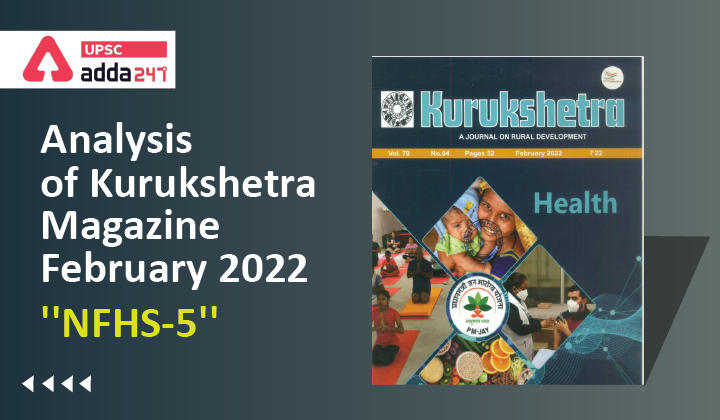Table of Contents
Analysis of Kurukshetra Magazine: NFHS-5
Relevance
”GS 2: Government Policies & Interventions, Health, Gender, Issues Related to Children, Issues Related to Women, Issues Relating to Development, Issues Relating to Poverty & Hunger”
Introduction
- The National Family Health Survey (NFHS-5) of 2019-21 was released by the Ministry of Health & Family Welfare (MoHFW) on the 24th November 2021.
- It comprises of Factsheets of key indicators on population, reproductive and child health, family welfare, nutrition and others for India and 14 States/UTs (clubbed under Phase-II).
- The States and UTs which were surveyed in the Phase-II were Arunachal Pradesh, Chandigarh, Chhattisgarh, Haryana, Jharkhand, Madhya Pradesh, NCT of Delhi, Odisha, Puducherry, Punjab, Rajasthan, Tamil Nadu, Uttar Pradesh and Uttarakhand.
Key Findings
TFR
- The Total Fertility Rates (TFR), the average number of children per woman has further declined from 2.2 to 2.0 at the national level and all 14 States/UT‘s ranging from 1.4 in Chandigarh to 2.4 in Uttar Pradesh.
- All Phase-II States have achieved replacement level of fertility (2.1) except Madhya
- Pradesh, Rajasthan, Jharkhand and Uttar Pradesh.
CPR
- Overall Contraceptive Prevalence Rate (CPR) has increased substantially from 54% to 67% at all India level and in almost all Phase-II States/UTs with an exception of Punjab.
Immunization
- Full immunization drives among children aged 12-23 months have recorded a substantial improvement from 62 per cent to 76 per cent at the all-India levels.
- This can be attributed to the flagship initiative of Mission Indradhanush launched by the government in December 2014.
Institutional Births
- Increased substantially from 79 per cent to 89 per cent at all-India levels.
Child Nutrition indicators
- Child Nutrition indicators show a slight improvement at an all-India level as Stunting has declined from 38 per cent to 36 per cent, wasting from 21 per cent to 19 per cent and underweight from 36 per cent to 32 per cent at all India level.
- Anaemia among children and women continues to be a cause of concern. More than half of the children and women (including pregnant women) are anaemic in all the phase-II States/UTs and all India level compared to NFHS4, in spite of substantial increase in the composition of iron-folic acid (IFA) tablets by pregnant women for 180 days or more.
Why are NFHS results important?
- The NFHS database is possibly the most important one because it not only feeds into the research needs and informs advocacy but also is central to both central and state-level policymaking.
- NFHS survey results also provide internationally comparable results. That’s because the questions and the methodology is internationally valid.
What do experts say on states?
- On several parameters, the number of states worsening over the last round — NFHS-4 (2015-16) — is not only high but often more than the number of states improving.
- What is most troubling is that on child malnutrition parameters — such as infant and child (under 5 years of age) mortality, child stunting (low height for one’s age), child wasting ( low weight for one’s height) and proportion of underweight children — several states have either been stagnant or worsened.
- In other words, children born between 2014 and 2019 (that is, 0 to 5 years of age) are more malnourished than the previous generation.
- The reversal in the proportion of children who are stunted is the most worrisome because unlike wasting and being underweight (which can be due to short term reasons and represent acute malnutrition), stunting represents chronic malnutrition. Reversals in stunting are unheard of in growing economies with stable democracies.
Conclusion
As NFHS is representative on a national and subnational (at the state and district levels) level, its findings on a range of indicators pertaining to health and nutrition, among others, from over 6 lakh sample households can assist policymakers in identifying crucial areas where better policy can provide course correction.



 TSPSC Group 1 Question Paper 2024, Downl...
TSPSC Group 1 Question Paper 2024, Downl...
 TSPSC Group 1 Answer key 2024 Out, Downl...
TSPSC Group 1 Answer key 2024 Out, Downl...
 UPSC Prelims 2024 Question Paper, Downlo...
UPSC Prelims 2024 Question Paper, Downlo...
